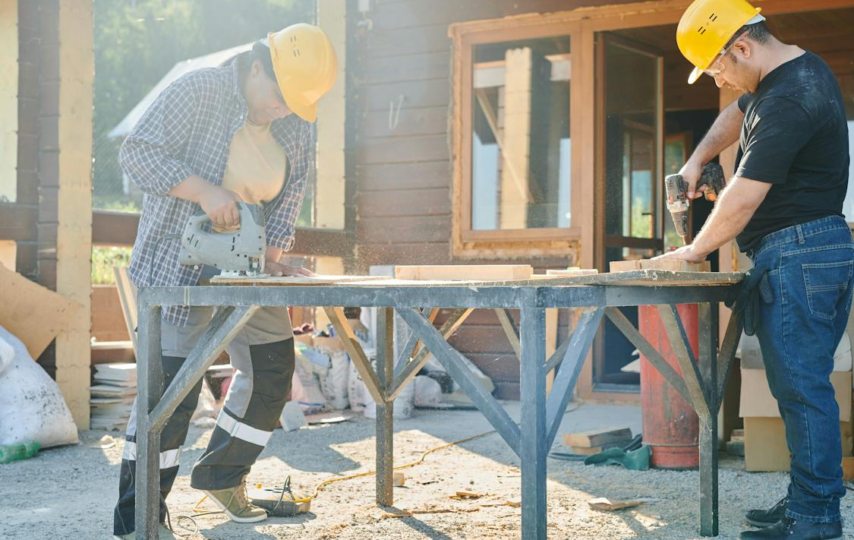The construction industry is on the cusp of a technological transformation that promises to fundamentally change how buildings, bridges, and infrastructure are created. During this transformative time, professionals and hobbyists must navigate an environment characterized by innovation, efficiency, and sustainability. As the industry progresses, the need for consistent learning and adjustment becomes clearer.
AtHomePrep advises keeping up with emerging technological advances and regulatory requirements is pivotal for anyone hoping to excel in construction, particularly in competitive markets like Florida. While new technologies and standards continually emerge, maintaining awareness of shifts helps professionals like you progress alongside industry changes and seize new opportunities. Though constant learning demands effort, keeping knowledge current aids success in this developing sector.
The Digital Shift: Construction’s New Frontier
The integration of digital technology within construction processes, often referred to as Construction Technology or ConTech, seeks to streamline operations by clarifying how tools digitize stages from project inception to conclusion. These digital instruments refine precision and enable a degree of teamwork difficult to achieve before. This digital change signifies more than a passing pattern but rather a meaningful advance in tackling customary industry struggles, including project postpones that surpass estimated deadlines, budgets that exceed planned costs, and workplace risks. While technology streamlines, it remains crucial we thoughtfully address human impacts and carefully design digital processes with user understanding and buy-in.
Building Information Modeling, or BIM, is one of the construction industry’s most innovative developments. Unlike conventional blueprints which provide a static two-dimensional view, BIM utilizes three-dimensional digital models to represent all aspects of a building from design through demolition. This dynamic process integrates vital details throughout a structure’s entire lifespan. By offering architects, engineers, and contractors a collaborative virtual environment, BIM enhances decision-making and coordination between teams.
Errors can be identified earlier in the planning process when changes are less costly. Resources and time are also used more efficiently with digital planning models. While still evolving, BIM demonstrates how emerging technologies may profoundly transform building design, construction, and facility management going forward. With continued innovation, the implementation of BIM holds great potential to minimize mistakes and maximize efficiency within the industry.
Harnessing the Power of AI and Machine Learning
While Artificial Intelligence (AI) and Machine Learning (ML) have become ubiquitous buzzwords across many industries in recent years, these technologies are beginning to play meaningful roles in transforming modern construction practices. Rather than merely buzzwords, AI and ML now underpin predictive analytics approaches that allow construction managers to more accurately foresee project outcomes.
By leveraging these methods, managers can proactively identify potential risks and develop stronger mitigation strategies. Through analyzing enormous troves of data from previous projects, weather patterns, and current site conditions, AI algorithms have the ability to anticipate project delays, equipment malfunctions, and supply chain interruptions before issues entirely arise. Such predictive insights grant construction teams more opportunity to circumvent complications and help ensure projects are completed on schedule and within budget.
Furthermore, AI, and ML have begun drastically changing the approach to ensuring safety on construction locations. By studying past incident records and continuously observing real-time circumstances on jobsites, these technologies can anticipate and stop occurrences, notably decreasing the chances of injuries and deaths. The utilization of AI-guided safety platforms represents an enormously important advance toward generating a work environment within the construction industry that promotes greater well-being and security.
The Rise of Sustainable Construction Practices
Sustainability has become essential rather than optional in the construction sector, necessitated by worldwide calls for environmental protection and judicious resource utilization. Technological progress is clearing a path for more sustainable construction methods, ranging from employment of eco-friendly substances to implementation of green building benchmarks. State-of-the-art software programs and simulation platforms empower architects and engineers to conceive structures that curtail vitality utilization, lessen waste products, and tap renewable energy origins.
Smart buildings fitted with sensors and connected appliances can help make structures more energy efficient, supporting environmental aims. These intelligent structures have the ability to independently change lighting, heating, and cooling based on occupancy and conditions, allowing optimal energy consumption. By automatically adjusting systems based on real-time inputs, smart buildings lessen electricity and fossil fuel usage..
Embracing the Technological Paradigm Shift
The construction industry is undertaking an exciting yet difficult transition towards greater technological integration. As digital tools and environmentally-friendly practices are becoming more inherent aspects of construction methods, having professionals who are skilled in both traditional building techniques and proficient with navigating new technologies is extremely important. Constant learning and adjustment are absolutely critical for those wanting to succeed within this continually changing field.
New innovations are being adopted at an impressive rate, requiring lifelong dedication to educational development from all construction professionals. While embracing progressive methods, the industry must also preserve crucial standard practices. Finding the proper balance will be key to supporting advancements without losing essential expertise. The coming years promise even more dramatic changes, making adaptability essential for ongoing achievement.







